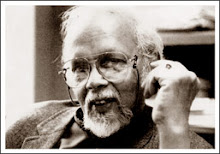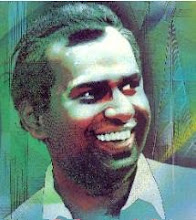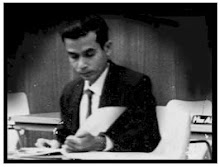Author: Ravi RathnavelDate:09/09/2010Source: Sarasaviya
අද සරසවිය වේදිකාවට ගොඩවෙන්නේ සෞන්දර්ය සරසවියේ රංගකලා ඇදුරකු ප්රවීණ නළුවකු හා නාට්ය නිර්මාණකරුවකු ද වන ප්රසන්නජිත් අබේසූරිය ය. මේ ඔහු සමඟ ඔහු ගේ සරසවි බිමේදී කළ සම්මුඛ සාකච්ඡාවකි.
රංගනය පැත්තට ඔබ යොමු වුණේ කොහොමද ?
පාසල් යන කාලේ ඉඳලම රඟපාන්න මට පුදුම ආශාවක් තිබුණා. මොකේද රඟපාන්නෙ කියන දේට වඩා කොහොමහරි රඟපාන්න ඕනය. නළුවෙක් වෙන්න ඕනය කියන පුදුමාකාර ආශාව නිසයි රංගනය පැත්තට යොමුවුණේ.
එතකොට රංගනය විෂයක් හැටියට හදාරන්න ඕනය කියන අවශ්යතාවය තිබුණෙ නැද්ද?
මමත් ඇතුළුව අපේ රටේ ඉන්න බොහෝමයක් නළු නිළියන් රංගනය ශාස්ත්රීයව හදාරලා, ගොඩක් දැනගෙන ආපු අය නෙවෙයි. මට හිතෙන හැටියට රඟපාන්න තියෙන වුවමනාව වගේ දේවල් නිසා තමයි මේ ක්ෂේත්රයට එන්නෙ. ගොඩක් දුරට මගෙත් ආරම්භය එහෙමයි.
නමුත් කාලයක් මේ ක්ෂේත්රයේ ඉද්දි වීදි නාට්ය කණ්ඩායමට ආවට පස්සෙ ගාමිණී හත්හොටුවගම මහත්තයා, ඊට පස්සෙ සරච්චන්ද්ර මහත්තයගෙ නාට්ය, සෝමලතා සුබසිංහ මත්මියගෙ නාට්ය, වගේ නාට්යකරුවන් එක්ක වැඩ කරන්න ගත්තට පස්සෙ, රඟපාන්න තියෙන ආශාවට කරන දේකට වඩා ගැඹුරු, ශාස්ත්රීය හැදෑරීමක් කළ යුතු, ආවට ගියාට කරන්න බැරි දෙයක් හැටියට තේරුම් අරගෙන නාට්ය හා රංග කලාව විෂයක් හැටියට හදාරන්න පෙළඹුනා.
 වඩා වැදග් න්යායාත්මක දැනුම ද ප්රායෝගික දැනුම ද කියන ප්රශ්නය දිහා ඔබ බලන්නෙ මොනවිදිහට ද?
වඩා වැදග් න්යායාත්මක දැනුම ද ප්රායෝගික දැනුම ද කියන ප්රශ්නය දිහා ඔබ බලන්නෙ මොනවිදිහට ද?
මෙහෙමයි අපේ රටේ බිහිවුණු ශ්රේෂ්ට නළුවො ගත්තොත් ඒ අය ආයතන ගතවෙලා රංගනය ඉගෙන ගත්තු අය නෙවෙයි. නමුත් විශිෂ්ට රංගන හැකියාවන් ඒ අය පෙන්නලා තියෙනවා.
සිනමාවේ ජෝ අබේවික්රම, ගාමිණී ෆොන්සේකා, මාලිනී ෆොන්සේකා වගේ නළු නිළියො ගත්තත්, වේදිකාවේ දැැවන්ත හා විශිෂට නළුවකු වන ජයලත් මනෝරත්නව ගත්තත් මේ කවුරුවත් ආයතන ගතවෙලා ශාස්ත්රීය විදිහට රංගනය හදාරපු අය නෙවෙයි. ඒ නිසා හොඳ රංගන ශිල්පියෙක් වෙන්න න්යායාත්මක දැනුම අත්යවශ්ය නෑ.
මේ අය රංගනය ඉගෙන ගෙන තියෙන්නෙ තමන්ගෙම ජීවන තක්සලාවෙන්. මේ අයගේ රංගනයේ ගැඹුර සාර්ථකත්වය මතු වෙන්නෙ අත්දැකීමෙන්. ඒකට හේතුව රඟපෑම කියන්නෙ සමාජයේ කොතැනක හෝ ජීවත් වූ හෝ ජීවත්විය හැකි යැයි හිතන පුද්ගල ස්වරූපයක් ප්රතිනිර්මාණය කිරීමක්. ඒක හරියට කරන්න නම් ඒකේ තාක්ෂණික පැත්ත, ශරීරය මෙහෙයවීම, හඬ පාලනය ගැන වගේම මනුෂ්ය ස්වභාවය ගැනත් හොඳ අවබෝධයක් තියෙන්න ඕන. මිනිස්සුන්ගෙ හැසිරීම්, ඔවුන්ගෙ ප්රතිචාර, ඇයි මිනිස්සුන්ට මෙහෙම වෙන්නෙ වගේ කාරනාත් ඉගෙන ගන්න වෙනවා.
ඒ ටික නොදන්න කෙනෙකුට මොන අභ්යාස කළත් වැඩක් නෑ. රංගනය ඉගෙන ගන්නවය කියලා සමහර ආයතන හා වැඩමුළුවල වේදිකා අභ්යාස කරනවා. අභ්යාසයෙන් විතරක් නළුවෙක් හැදෙන්නෙ නෑ. ඒ නළුවා තුළ පරිකල්පනය දියුණුවෙන්න නම් අනිවාර්යයෙන්ම ජීවන අත්දැකීම් තියෙන්නම ඕන. ඒක නැතුව රංගනය ඉගෙන ගන්නවය කියන්නෙ බොරු වැඩක්.
මෙතෙන්දී අධ්යාපන පසුබිම කියන්නෙ වෙනම එකක්. රංගන වැඩමුළුවලින් හෝ විශ්ව විද්යාල මට්ටමින් මේ විෂයේ න්යායාත්මක පැත්ත ඕනෑම කෙනෙකුට ඉගෙන ගන්න පුළුවන් නමුත් හොඳ නළුවෙකු වෙන්න නම් ඉහතින් කියපු ගුණාංග තියෙන්නම ඕන.
රංගනය කියන දේ ඔබ විග්රහ කරන්නෙ මොන විදිහට ද?
මම විශ්වාස කරන විදිහට නම්, මේ මහපොළව උඩ කොතැනක හෝ ජිවත්වන මිනිසුන් සහ ඔවුන්ගේ අනවතර ජීවන අරගලය සහ ඊට ඔවුන් දක්වන ප්රතිචාර වේදිකාව මත හෝ කැමරාව ඉදිරියේ ඒ සඳහා වූ සුදුස්සන් විසින් ප්රති නිර්මාණය කිරීම තමයි රංගනය කියලා කියන්නෙ.
ඒ අර්ථයෙන් අපි රඟපානවය කියල කරන්නෙ මේ ලෝකෙ කොහෝ හෝ හිටපු ජීවත් වුණු හෝ ජීවත් වන ගැහැනුන් සහ මිනිසුන්ගේ හැසිරීම් රටාව, මනුෂ්ය ස්වභාවය අවංකව සහ ඒ චරිතවලට සාධාරණයක් වන විදිහට ප්රති නිර්මාණය කිරීමයි. රඟපෑමේ තියෙන තාක්ෂණික පැත්ත, රංගන න්යායන් වගේ දේවල්වලටත් වඩා වැදගත්ම දේ තමයි රංග අභ්යාසයන්ගෙන් නම්යශීලී කරගත්තු ශරීරය.
පුහුණු කර ගත්තු හඬ වගේ දේවල් ඇසුරෙන් මනුෂ්යත්වය ප්රතිනිර්මාණ කිරීම. ඒ නිසා මිනිස්සු ගැන වඩ වඩාත් ඉගෙනීම රංග කාර්යයට අවශ්යයයි. තමන් නිරූපණය කරන චරිතයට සාධාරණය ඉෂ්ඨ කරන්න පුළුවන් වෙන්නෙ එතකොටයි.
මගේ දැනීමේ හැටියට මනුෂ්යත්ව ඉගෙන ගන්න පුළුවන් හොඳම තැන තමයි ජීවන තක්සලාව. ලෝකෙ වටේම තියෙන රංග පාසල්වලට ගියත් ඉගෙන ගන්න බැරි දේ, අපට ඉගෙන ගන්න පුළුවන්කම තියෙන්නෙ ජීවන තක්සලාවෙන්. මට හිතෙන්නෙ අපේ රටේ වැඩියෙන්ම ඉන්නෙත් ජීවන තක්සලාවෙන් ඉගෙන ගත්තු නළු නිළියන් තමයි.
වේදිකාව නළුවගෙ මාධ්යය කියන කාරණය දිහා ඔබ බලන්නෙ මොන විදිහට ද ?
වේදිකා නාට්යයක අදියුරු එහෙමත් නැත්නම් එය වේදිකාව මත රඟ දැක්වීමටත් කලින් මනසින් දකින කෙනා වෙන්නෙ අධ්යක්ෂවරයයි. මෙය සිනමාවට වගේම ටෙලි නාට්යයටත් මේ විදිහටම අදාළයි. අධ්යක්ෂවරයා ගේ මනස් කරළිය මත රඟදක්වා අවසන් වූ දෙයක් තමයි. ඔහු අප හමුවේ ප්රතිනිර්මාණය කරන්නෙ. ඔහුගේ මනසේ මැවුණු දේ යථාර්ථයක් කිරීම එයට සම්බන්ධ වන අනෙකුත් අයගෙ වගකීම බවට පත් වෙනවා.
ඒ සඳහා අධ්යක්ෂවරයාගේ අවශ්යතාවය හඳුනාගන්න සිද්ධ වෙනවා. නළුවෙක් නම් තමන්ට ලැබුණු චරිතයෙන් අධ්යක්ෂවරයා මතුකරගන්න හදන්නෙ මොන විදිහේ මනුෂ්ය ස්වභාවයක් ද කියන දේ නිවැරැදිව හඳුනාගන්න, අවබෝධ කරගන්න වෙනවා. අවසානයේ අධ්යක්ෂවරයා ගේ රූකඩයක් බවට පත් නොවී එකී චරිතය තමන් අතිනුත් පෝෂණය කරමින් හැකි උපරිම සාධාරණයක් ඒ චරිතයට ඉටුකිරීම තමයි වැදගත් වෙන්නෙ.
වේදිකාව නළුවාගේ මාධ්ය බවට පත්වෙන්නෙ රංගනයේ දී නළුවා තම ආධිපත්ය දරනවාය කියන තත්ත්වය තුළයි. නාට්ය කලාව සජීවී මාධ්යයක් නිසා තමයි නළුවට මේ ආධිපත්ය ලැබෙන්නෙ.
 පිටපත මොනතරම් ප්රබල වුණත්, පෙර පුහුණුවීම් කොතරම් සාර්ථක වුණත් නාට්ය රඟ දක්වන මොහොතේ අදාළ නළුවාගේ කායික මානසික තත්ත්වය උඩ තමයි ඒ මොහොතේ රංගනය තීරණය වෙනනේ.
පිටපත මොනතරම් ප්රබල වුණත්, පෙර පුහුණුවීම් කොතරම් සාර්ථක වුණත් නාට්ය රඟ දක්වන මොහොතේ අදාළ නළුවාගේ කායික මානසික තත්ත්වය උඩ තමයි ඒ මොහොතේ රංගනය තීරණය වෙනනේ.
මේ නිසා නාට්ය රඟ දැක්වෙන මොහොතේ ප්රේක්ෂකයා ඉදිරියේ ඉන්න නළුවට පුළුවන් නාට්ය ඇති කරන්න හෝ නැති කරන්න. අධ්යක්ෂවරයා, පිටපත අංග රචනය, ආලෝකය, පසුතලය මේ හැම දේම ප්රේක්ෂකයා දකින්නෙ නළුවා හරහා. ඒ නිසයි රංගනයේදී නළුවා ප්රමුඛයා වෙන්නෙ.
නමුත් නාට්ය නිර්මාණ කාර්යයයේදී ප්රමුඛයා වෙන්නෙ අධ්යක්ෂවරයයි. නාට්ය රඟ දැක්වෙන මොහොත දක්වාම එය අධ්යක්ෂවරයාගේ කලාවය කියන එකයි මගේ අදහස . රංග කාර්යයේදී නළුවා ගේ කාර්ය අති විශිෂ්ටයි.
වගකීම් සහගතයි වගේම බලසම්පන්නයි. නමුත් නාට්යයක අවසාන තීරකයා වෙන්නෙ අධ්යක්ෂවරයයි. අධ්යක්ෂවරයා මනසින් දුටු නිර්මාණය එලෙසින්ම වේදිකාව මත යළි ප්රති නිර්මාණය කරන වැඩේදි ඔහු සහ ඔහුගේ කණ්ඩායම අතර අවබෝධාත්මක සහෝදරත්වයක් තියෙන්න ඕනය කියලයි මම හිතන්නෙ.
රංග කාර්ය උගන්වන ගුරුවරයකු හැටියට කියන දේවල් හා නිර්මාණ ක්ෂේත්රයේ දී ප්රායෝගිකව කරන්න සිද්ධවන දේ අතර හිඩස ඔබට ම අභියෝගයක් වෙන්නෙ නැද්ද?
පැහැදිලිවම මට වගේ අයට ඒ අභියෝගයට මුහුණ දෙන්න සිද්ධවෙනවා. නාට්ය හා මුද්රානාට්ය අධ්යන අංශ ප්රධානියා හැටියට ඒ වගකීම තවත් වැඩිවෙනවා. මුල් කාලේ මම මෙගා නාට්යවලට එහෙමත් සම්බන්ධවෙලා ඉන්දැද්දී ළමයි මගෙන් අහන්න ගත්තා සර් මෙතන කියන දේයි අතන රඟපාන විදිහයි ගැළපෙනවද කියලා.
සමහර ළමයි මටම කියලා තියෙනවා මේ රඟපාන්නෙ අපේ සර්ය කියලා කිව්වම ඒ අයගෙ දෙමවුපියො ඒක පිළිගන්නෙ නැහැයි කියලා. දැන් දැන් මම රංගනය මගේ වෘත්තීය එහෙමත් නැත්නම් ජීවනෝපාය කරගෙන නැති නිසා තෝරා බේරාගෙන රඟපානවා.
ඒනිසා කලාතුරකින් හොඳ ටෙලිනාට්යයකට දායක වෙනව හැරෙන්න මගේ රඟපෑම වේදිකාවට පමණක් සීමාකරගෙන තියෙනවා. හැබැයි මෙච්චර කාලෙකට මම සම්බන්ධ වුණු චරිතයකට හෝ නිර්මාණයකට හානියක්, අවැඩක්වෙන විදිහට මම ඒ දේ කරලා නෑ කියන ආත්ම තෘප්තිය මට තියෙනවා.
සාර්ථක රංගන ශිල්පියෙක් වෙන්න ආශාව විතරක් තිබුණට ප්රමාණවත් ද ?
රංගන ශිල්පියෙකුට තියෙන්නෙම ඕන දේ තමයි ජීවන අත්දැකීම. අපි රඟපාන්න ගියාම අත් දකින ඛේදනීය තත්ත්වයක් තමයි මතුපිට ලෝකවල සුරංගනා ලෝකවල ජීවත්වුණු ජීවන අත්දැකීම් නැති අයත් එක්ක නිර්මාණවලට දායක වෙන්න සිදුවීම.
කොස්සකින් අතුගාන ළිඳකින් වතුර අදින, දර ටිකක් පළන වගේ දෙයක්වත් ව්යාජ විදිහට නිරූපණය කරන්න බැහැ. ඒ නිසා මිනිස් ජීවිතය හා සිතුම් පැතුම් මිනිසුන් සමඟ ජීවත්වීමෙන් අවබෝධ කරගන්න ඕන. වේදිකා නළුවෙක් වෙන්න නම් අභ්යාසය අනිවාර්යෙන්ම තියෙන්න ඕන. හේතුව රඟපෑම උගන්නන් පුළුවන්කමක් නෑ.
අනිත් පැත්තෙන් වේදිකා රංගන ශිල්පියකුට සිනමා හෝ ටෙලි නළුවෙකුට වගේ තාක්ෂණය මත යැපෙන්න පුළුවන්කමක් නෑ. මේ මාධ්යවල නළුවාට දෙබස් කියන්න බැරි නම් ඩබ් කරන්න පුළුවන්. අවශ්ය රංගනය හරි මදි නම් නැවත නැවත රූගත කරන්න පුළුවන්. සංස්කරණය කරන්න පුළුවන්.
නමුත් වේදිකාවෙ මේ දේවල්වලට ඉඩක් නෑ. ප්රේක්ෂකයා ඉදිරියට යන රංගන ශිල්පියාගේ කේශාන්තයේ සිට පාදාන්තය දක්වාම අමු අමුවේ ප්රේක්ෂකයාට සජීවීවම පේනවා. ගායනය, දෙබස් මේ හැමදේම තමන්ම ඉදිරිපත් කරන්න ඕන. ඒ වගේම පැය දෙක තුනක් එක දිගට වේදිකාවේ රැඳීල ඉන්න ජවය තියෙන්න ඕන.
මතක ශක්තිය, හඬ පාලනය, වගේ දේවල් දීර්ඝ පුහුණුවකින් වග දිහා කරගන්න ඕන. වේදිකාවේ ස්වභාවය අනුව හැඩ ගැහෙන්න දැනගෙන ඉන්න ඕන.
මේ දේවල් ළඟා කරගන්න නම් අනිවාර්යයෙන්ම කැපවීම හා අභ්යාසය තිබිය යුතුමයි. ඒ වගේම රංගනය ගැන නා්යායාත්මක හා ප්රායෝගික දැනුම ලබා ගන්නත් ඕන.
හේතුව මෙලෝ යකෙකුට රඟපාන්නෙ වෙන්න මෙහෙමයි කියලා උගන්නන්න බෑ. යමෙකුට රඟපෑමට අවශ්ය කායික මානසික සූදානම් කිරීමක් විතරයි කරන්න පුළුවන්.
මොළයයි හදවතයි, ශරීරයයි එකට බද්ධ කරලා තම ප්රකාශනය එළියට ගේන ලෝකේ එකම මාධ්ය තමයි රංගනය. රංගනයක් සාර්ථකවෙන්න මොළෙන් දැනගෙන හදවතින් විඳිමින් ශාරීරිකව ඒ දේ ප්රකාශ කිරීම කළ යුතු වෙනවා.
 රඟපෑම කියලා රංගන ශිල්පියකුට උගන්වන්නේ රඟපෑම සඳහා අවශ්ය කායික මානසික සූදානම් කිරීම විතරයි. රංගනය ඉගෙන ගන්න නම් අභ්යාස කළ යුතුයි. අත්දැකීම් ලැබිය යුතුයි. නැත්නම් ගොඩ ඉඳන් පිහිනන් උගන්නනවා වගේ වෙනවා. රඟපෑම උගන්නන්න ගිය දවසක නළුවා මැරිලා රූකඩයක් හෝ අච්චු තමයි බිහිවෙන්නෙ.
රඟපෑම කියලා රංගන ශිල්පියකුට උගන්වන්නේ රඟපෑම සඳහා අවශ්ය කායික මානසික සූදානම් කිරීම විතරයි. රංගනය ඉගෙන ගන්න නම් අභ්යාස කළ යුතුයි. අත්දැකීම් ලැබිය යුතුයි. නැත්නම් ගොඩ ඉඳන් පිහිනන් උගන්නනවා වගේ වෙනවා. රඟපෑම උගන්නන්න ගිය දවසක නළුවා මැරිලා රූකඩයක් හෝ අච්චු තමයි බිහිවෙන්නෙ.
නළුවෙක් හැටියට ශෛලිගත නාට්යවල වගේම තාත්වික නාට්යවලත් රඟපාන ඔබ ඒ දහරා දෙක දිහා බලන්නෙ මොන විදිහටද ?
පැහැදිලිවම මේ දෙකේ ආකෘතික හා ඉදිරිපත් කිරීම පැත්තෙන් වෙනසක් තියෙනවා. ශෛලි ගත නාට්යයක භාව ප්රකාශනයෙයි. තාත්වික එහෙමත් නැත්නම් ලෝකධර්මී නාට්යයක භාව ප්රකාශනය වන විදිහයි අතර වෙනසක් තියෙනවා.
මේ ඉදිරිපත් කිරීමේ ශෛලියේ වෙනස්කම් තිබුණට මම විශ්වාස කරන්නෙ මේ දෙකෙන්ම ඉදිරිපත් වෙන්නෙ මනුෂ්යත්වය කියලයි. මිනිස්සුන්ට හැෙඟන දැනෙන දේ එකයි.
ජීවිතයේ දැනෙන විඳින දේ තමයි ඔය කිව්ව රාමු දෙකෙන් එකකට දාන්නෙ. සිංහ බාහු නාට්යයේ සිංහයාට කාලෙකට පස්සෙ තමන්ගෙ පුතාව දැක්කම ඇති වන හැඟීමයි.
කැලණි පාලමේ චුට්ටෙට අවුරුදු ගාණකට පස්සෙ සරණපාලව දැක්කම ඇතිවන හැඟීමයි තමන්ගෙ පුතා දැකීමෙන් ඇතිවන පීතෘ සෙනෙහස හැටියට එකයි. මේ හැඟීම ලෝකෙ කොතනක කාට ඇති වුණත් එකයි.
නමුත් ඒ හැඟීම ප්රකාශ වෙන්නෙ විධි දෙකකට. සිංහබාහුව දැක්කම සිංහයාට ඇතිවන හැඟීම කියවෙන්නෙ ගස් මුදුන්වලින් හඳපායගෙන එන කොට කුමුදු මල් පිපුනා වගේ කියලා. නමුත් කැලණි පාලමේ චුටටෙ අතින් මේ අත්දැකීම වචනවලට පෙරලන්නෙ, පුතේ කොච්චර දෙයක්ද උඹ දැක්ක එක.
හරියට කට්ට කළුවරේ හඳ පෑව්වා වගේ කියලා. නමුත් මෙතනදී චුට්ටෙ කිව්ව නම් තුරුහිසින් නැගී සේ තරින්ද, නුඹ මා දකින්නට ආවා. කියලා මිනිසුසු හිනා වෙනවා. මේ දහරා දෙකේම රඟපාන කෙනෙක් හැටියට මම හැම වෙලාවෙම උත්සහ කරන්නෙ යථාර්ථවාදීව බලන්නයි.
ස්වතන්ත්ර හා පරිවර්තන කියන ප්රවේශයන් ගැන ඔබට තියෙන්නෙ මොනවගේ අදහසක් ද?
ස්වතන්ත්රද පරිවර්තනද කියනවට වඩා මම බලන්නෙ කෘතියේ අර්ථය මොකක්ද ඒක අපේ රටට ගැළපෙනවද කියන කාරනා ගැනයි. කොච්චර උසස් පරිවර්තනයක් වුණත් ඒක අපේ රටට සමාජයට ගැළපෙන්නෙ නැත්නම් ඒ නිර්මාණය අපේ කරණය වෙන්නෙ නැත්නම් ඒකෙන් ඇති වැඩක් නෑ.
අනිත් කාරණය තමයි අපේ රටේ හුඟක්ම ජනප්රිය වුණේ. හුණුවටයේ කථාව, මුහුදු පුත්තු, බෙරහඬ, බක්මහ අකුණු, තාරාවෝ ඉගිලෙති වගේ නාට්ය දේශීය කරණයට ලක් වූ නාට්ය, විදේශ කෘති වචනෙන් වචනෙ පරිවර්තනය කරලා ගෙඩි පිටින් අපේ මිනිස්සුන්ට පෙන්නුවම ඒක ප්රේක්ෂකයාට දුරස් අත්දැකීමක් වෙනවා.
වඩා වැදගත් ප්රේක්ෂක රස වින්දනයනෙ අන්න ඒක ඉටුවෙන්නෙ නැත්නම්, ප්රේක්ෂකයා ඒ නිර්මාණ වැළඳ ගන්නෙ නැත්නම් ඒ නිර්මාණයෙන් වැඩක් නෑ. මේ නිසා පෞද්ගලිකව මම නම් වඩා කැමැති ස්වතන්ත්ර නාට්ය වලටයි. හේතුව අපි කොතරම් හොඳ පරිවර්තන හෝ අනුවර්තන නාට්ය කළත් ඒකෙන් දක්ෂ නළුවන් හොඳ නිෂ්පාදන බිහිවෙයි.
නමුත් ඒකෙන් දේශීය නාට්ය කලාවක් ගොඩනැගෙන්න ලැබෙන දායකත්වය මොකක්ද ඒ නාට්යයක් අපේ දේශීය නාට්යයක් හැටියට පිට රටකට ගිහින් පෙන්නන්න පුළුවන්කමක් තියෙනවද ? විදෙස් ආභාෂය ලබන්න ඕන.
ඒක අත්දැකීමක් කරගෙන අපේම නිර්මාණයක් බිහිකිරීමයි වඩා හොඳ අද ඉන්න අපේ සමහර තරුණ නිර්මාණකරුවන්ට සාර්ථක වෙන්න බැරි වෙන්න ප්රධාන හේතුවත් මෙන්න මේ දේ වටහා නොගැනීමය කියලයි මට හිතෙන්නෙ. ඒ අය කතාකරන විෂයන්. කතා කරන විදිහ, තේමාව තුළ ආර්ට් කියන එක නැතිවෙලා අමු ගතියක් මතුවෙන්නෙ ඒකයි.
ඒ වගේ නාට්යයක් පළමුවරට බලන ප්රේක්ෂකයා ආයෙ ජීවිතේට නාට්යයක් බලන එකක් නෑ. මෙන්න මේ වගේ හේතු නිසා දේශීය නාට්ය කලාව පෝෂණය වෙන්න නම් ස්වතන්ත්ර නාට්ය බිහිවීම වඩා හොඳයි කියලයි මට හිතෙන්නෙ.
නාට්ය ඇගයීම් සම්මාන වගේ දේවල් ගැන ?
සම්මාන උළෙලක සිද්ධවෙන ගාල ගෝට්ටියට ප්රධාන හේතුවක් තමයි අපි පුංචි රටක් වීම හා ඊට සම්බන්ධ වන සියල්න් අපි කවුරුත් පෞද්ගලීකව දැන සිටීම. මේ නිසා මේ ඇගයීම් කරන අය ඒ සඳහා සුදුස්සෝද කියන ප්රශ්නයත් එක්කයි අපේ රටේ සම්මාන සඳහා වන ඇගැයීම් මහා අච්චාරුවක් බවට පත්වෙන්නෙ.
අනිත් කාරනේ අපේ නිහතමානී කමක් නැතිකම. අපි පිළිගන්න සූදානම් නෑ. අපි අසාර්ථකයි කියලා. අලුත් කෙනෙකුට සම්මානයක් ලැබුණම ඒක දරා ගන්න. පිළිගන්න අපි සූදානම් නෑ. ගිය අවුරුද්දේ යෞවන නාට්ය සම්මාන රැසක් දිනපු අපේ විශ්ව විද්යාලයේ නාට්ය රාජ්ය නාට්ය උළෙලේ දෙවැනි වටයෙන්ම අයින් කළා අසභ්ය යයි කියලා.
මේනාට්යයේ ගණිකාවෝ ඉන්නව, අසභ්ය වචන තියනවය කියන එක තමයි හේතුව. නමුත් මේ නාට්ය ලිව්වෙ කමලාදාස් ගේ a dall For a child prostitute කියන ගණිකා මඩමක් ඇසුරෙන් ලියවුණු කතාවක් මත. මේ නාට්ය විනිශ්චය කරපු අය කිව්වෙ ඒ නාට්ය දර්ශන දැක්කම ඒ අයට හිරිකිත හිතිලා ඇඟේ හිරුගඩු පිපුනලු.
එතකොට හිතාගන්න පුළුවන්නෙ ඒ අයගෙ නිර්මාණ රසවින්දනයේ ප්රමාණය. මේවා මෙහෙම වෙන්නෙ පෞද්ගලීකත්වය, බැඳීම් ඇලීම් ගැලීම් නිසා. ඒ වගේම කෝන්තරත්, මේවට බලපානවා. කොහොම වුණත් නිර්මාණකරුවන් විනිශ්චය මණ්ඩලයේ ඉන්නට පෞද්ගලීකව මම නම් කැමැති නෑ. මමත් හිටපු නිසා කියන්නෙ එහෙම වුණාම නිර්මාණය දිහා බලනවා වෙනුවට මම මගේ ටේස්ට් එක, චින්තනය, ස්ටයිල් එකට මම ඒ නාට්ය මනසින් ඩිරෙක්ට් කරන එකයි කරන්නෙ. ඒ වගේම තමන්ට වඩා දක්ෂ නම් කපලා දාන එක, ගිය පාර කැලණියට තැන දෙන්න අපිව කපලා දැම්මා වගේ කැපිලා යනවා.
ඊළඟට ශාලා වෙන්කර ගන්න පුළුවන් දින ගානට නාට්ය සීමා කරගෙන ඒ සීමිත නාට්ය අතුරෙන් තමන් කැමැති එක තෝරනවා වගේ දේවල් අපේ රටේ තමයි සිද්ධ වෙන්නෙ. සම්මාන නිර්මාණකරුවෙකුට ශක්තියක් තමයි.
නමුත් නිර්මාණයක පැවැත්ම සාර්ථකත්වය තීරණය වෙන්නෙ සම්මාන මත නෙවෙයි. සිංහබාහු, කැලණිපාලම, හුණුවටයේ කථාව, නරි බෑනා, ගජමන් පුවත ඔය එකක්වත් සම්මාන දිනපු නාට්ය නෙවෙයි. නමුත් එදා සිට අද දක්වාම ඒ නාට්ය ජනතාව අතර පවතිනවා.
ඡායාරූප මාලන් කරුණාරත්න









 වඩා වැදග් න්යායාත්මක දැනුම ද ප්රායෝගික දැනුම ද කියන ප්රශ්නය දිහා ඔබ බලන්නෙ මොනවිදිහට ද?
වඩා වැදග් න්යායාත්මක දැනුම ද ප්රායෝගික දැනුම ද කියන ප්රශ්නය දිහා ඔබ බලන්නෙ මොනවිදිහට ද? පිටපත මොනතරම් ප්රබල වුණත්, පෙර පුහුණුවීම් කොතරම් සාර්ථක වුණත් නාට්ය රඟ දක්වන මොහොතේ අදාළ නළුවාගේ කායික මානසික තත්ත්වය උඩ තමයි ඒ මොහොතේ රංගනය තීරණය වෙනනේ.
පිටපත මොනතරම් ප්රබල වුණත්, පෙර පුහුණුවීම් කොතරම් සාර්ථක වුණත් නාට්ය රඟ දක්වන මොහොතේ අදාළ නළුවාගේ කායික මානසික තත්ත්වය උඩ තමයි ඒ මොහොතේ රංගනය තීරණය වෙනනේ.  රඟපෑම කියලා රංගන ශිල්පියකුට උගන්වන්නේ රඟපෑම සඳහා අවශ්ය කායික මානසික සූදානම් කිරීම විතරයි. රංගනය ඉගෙන ගන්න නම් අභ්යාස කළ යුතුයි. අත්දැකීම් ලැබිය යුතුයි. නැත්නම් ගොඩ ඉඳන් පිහිනන් උගන්නනවා වගේ වෙනවා. රඟපෑම උගන්නන්න ගිය දවසක නළුවා මැරිලා රූකඩයක් හෝ අච්චු තමයි බිහිවෙන්නෙ.
රඟපෑම කියලා රංගන ශිල්පියකුට උගන්වන්නේ රඟපෑම සඳහා අවශ්ය කායික මානසික සූදානම් කිරීම විතරයි. රංගනය ඉගෙන ගන්න නම් අභ්යාස කළ යුතුයි. අත්දැකීම් ලැබිය යුතුයි. නැත්නම් ගොඩ ඉඳන් පිහිනන් උගන්නනවා වගේ වෙනවා. රඟපෑම උගන්නන්න ගිය දවසක නළුවා මැරිලා රූකඩයක් හෝ අච්චු තමයි බිහිවෙන්නෙ.

































